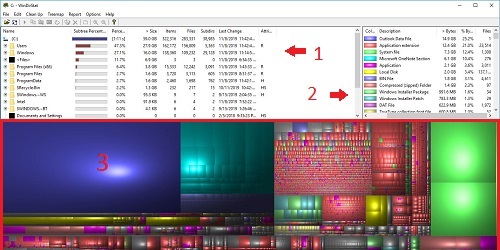

The files can be deleted directly in your Windows Explorer menu or the WinDirStat user interface.

You can view the files to ensure that you do not delete important items. The file explorer window will appear to let you safely click on the contents of a folder. You can right-click on the records to press ‘Explorer Here’. WinDirStat lets you view the items in your Windows Explorer menu. The folders list the total number of items and files inside. The name, percentage bar, and size are listed for each level of the directory tree. WinDirStat lets you know what percentage of the drive is being used by each folder and file.

The largest archives will be listed at the top. The usage statistics will be available for all the records, even when the file types use zero space. The tree view of the whole directory lets you completely expand the contents of each folder. You can click on items in either of the lists to see the section in the statistics viewer. The extension list is categorised by colour and size. The whole contents of your disk drive will be listed in descending order on the right. The ‘addition sign’ next to the items will let you open the trees while the ‘minus sign’ will minimise the subtrees. The directory tree lets you expand each segment. The sizes of the rectangles are proportional to the amount of disk space each of the files are using. The bottom portion of the interface includes a treemap of the directory statistics. The disk statistics for the entire analysis are in the right panel. An ‘All Local Drives’ button lets you conveniently scan every drive or you can scan individual folders.Ī list of the disk inventory is located on the left. You can scan individual or multiple drives at the same time. WinDirStat delivers a comprehensive file list of the disk usage on your HD or SSD. Although WinDirStat does not work on Linux nor MacOS, you can get KDirStat for Linux and QDirStat for Mac. You can download and install WinDirStat on all of the most recent versions of the Windows OS. WinDirStat works on Windows 10 operating systems.


 0 kommentar(er)
0 kommentar(er)
